Spectral Mixture Analysis (SMA) Model for Extracting Urban Fractions from Landsat and Sentinel-2A Images in the Al-Ahsa Oasis, Eastern Region of Saudi Arabia
Abstract
:1. Introduction
2. Description of the Study Site
3. Materials and Methods
3.1. Datasets
3.1.1. Landsat Images
3.1.2. Sentinel-2A Images
3.1.3. Population Data
3.2. Methodology
3.2.1. Preprocessing of Images
3.2.2. The Oasis’ Urban Area Extraction Using SMA
3.2.3. Endmember Selection
3.2.4. Accuracy Assessment Methods
3.2.5. Driving Forces of Urban Fraction Dynamics
4. Results and Discussion
4.1. Endmember Spectra and SMA
4.2. Urban Fractions
4.3. Accuracy Assessment
4.4. Driving Forces and Consequences of Urban Fraction Changes
5. Conclusions
Funding
Data Availability Statement
Acknowledgments
Conflicts of Interest
References
- Abdulaziz, I.A.; Cobbinah, P.B. Urbanizationenvironment conundrum: An invitation to sustainable development in Saudi Arabian cities. Int. J. Sustain. Dev. 2023, 30, 359–373. [Google Scholar]
- Xu, C.; Liu, M.; An, S.; Chen, J.M.; Yan, P. Assessing the impact of urbanization on regional net primary productivity in Jiangyin County, China. J. Environ. Manag. 2007, 85, 597–606. [Google Scholar] [CrossRef] [PubMed]
- Salih, A.; Hassaballa, A.A.; Ganawa, E. Mapping desertification degree and assessing its severity in Al-Ahsa Oasis, Saudi Arabua, using remote sensing-based indicators. Arab. J. Geosci. 2021, 14, 192. [Google Scholar] [CrossRef]
- Almadini, A.M.; Hassaballa, A.A. Depicting changes in land surface cover at Al-Hassa oasis of Saudi Arabia using remote sensing and GIS techniques. PLoS ONE 2019, 14, e0221115. [Google Scholar] [CrossRef]
- Abdelatti, H.; Elhadary, Y.; Babiker, A.A. Nature and Trend of Urban Growth in Saudi Arabia: The Case of Al-Ahsa Province—Eastern Region. Resour. Environ. 2017, 7, 69–80. [Google Scholar]
- Salih, A.A.; Ganawa, E.T.; Elmahl, A.A. Spectral mixture analysis (SMA) and change vector analysis (CVA) methods for monitoring and mapping land degradation/desertification in arid and semiarid areas (Sudan), using Landsat imagery. Egypt. J. Remote Sens. Space Sci. 2017, 20, S21–S29. [Google Scholar] [CrossRef]
- Bouzekri, S.; Lasbet, A.A.; Lachehab, A. A new spectral index for extraction of built-up area using Landsat-8 data. J. Indian Soc. Remote Sens. 2015, 43, 867–873. [Google Scholar] [CrossRef]
- Bhatti, S.S.; Tripathi, N.K. Built-up area extraction using Landsat 8 OLI imagery. GIScience Remote Sens. 2014, 51, 445–467. [Google Scholar] [CrossRef]
- Deliry, S.I.; Avdan, Z.Y.; Avdan, U. Extracting urban impervious surfaces from Sentinel-2 and Landsat-8 satellite data for urban planning and environmental management. Environ. Sci. Pollut. Res. 2021, 28, 6572–6586. [Google Scholar] [CrossRef] [PubMed]
- Firozjaei, M.K.; Sedighi, A.; Kiavarz, M.; Qureshi, S.; Haase, D.; Alavipanah, S.K. Automated built-up extraction index: A new technique for mapping surface built-up areas using LANDSAT 8 OLI imagery. Remote Sens. 2019, 11, 1966. [Google Scholar] [CrossRef]
- Lamqadem, A.A.; Afrasinei, G.M.; Saber, H. Analysis of Landsat-derived multitemporal vegetation cover to understand drivers of oasis agroecosystems change. J. Appl. Remote Sens. 2019, 13, 014517. [Google Scholar] [CrossRef]
- Dawelbait, M.; Dal Ferro, N.; Morari, F. Using Landsat Images and Spectral Mixture Analysis to Assess Drivers of 21-Year LULC Changes in Sudan. Land Degrad. Dev. 2017, 28, 116–127. [Google Scholar] [CrossRef]
- Khiry, M.A. Spectral Mixture Analysis for Monitoring and Mapping Desertification Processes in Semi-Arid Areas in North Kordofan State, Sudan. Ph.D. Thesis, Technische Universität Dresden—TU Dresden, Dresden, Germany, 2007. [Google Scholar]
- Dawelbait, M.; Morari, F. Monitoring desertification in a Savannah region in Sudan using Landsat images and spectral mixture analysis. J. Arid. Environ. 2012, 80, 45–55. [Google Scholar] [CrossRef]
- Liu, T.; Yang, X. Mapping vegetation in an urban area with stratified classification and multiple endmember spectral mixture analysis. Remote Sens. Environ. 2013, 133, 251–264. [Google Scholar] [CrossRef]
- Tooke, T.R.; Coops, N.C.; Goodwin, N.R.; Voogt, J.A. Extracting urban vegetation characteristics using spectral mixture analysis and decision tree classifications. Remote Sens. Environ. 2009, 113, 398–407. [Google Scholar] [CrossRef]
- Du, P.; Liu, S.; Liu, P.; Tan, K.; Cheng, L. Sub-pixel change detection for urban land-cover analysis via multi-temporal remote sensing images. Geo-Spat. Inf. Sci. 2014, 17, 26–38. [Google Scholar] [CrossRef]
- Small, C. High spatial resolution spectral mixture analysis of urban reflectance. Remote Sens. Environ. 2003, 88, 170–186. [Google Scholar] [CrossRef]
- Hassaballa, A.; Salih, A. A Spatio-Temporal Analysis of Heat Island Intensity Influenced by the Substantial Urban Growth between 1990 and 2020: A Case Study of Al-Ahsa Oasis, Eastern Saudi Arabia. Appl. Sci. 2023, 13, 2755. [Google Scholar] [CrossRef]
- Salih, A. Classification and mapping of land cover types and attributes in Al-Ahsaa Oasis, Eastern Region, Saudi Arabia using Landsat-7 data. J. Remote Sens. GIS 2018, 7, 228–234. [Google Scholar] [CrossRef]
- General Authority for Statistics (2010). Available online: https://www.stats.gov.sa/en (accessed on 12 June 2020).
- Aldakheel, Y.Y. Assessing NDVI Spatial Pattern as Related to Irrigation and Soil Salinity Management in Al-Hassa Oasis, Saudi Arabia. J. Indian Soc. Remote Sens. 2011, 39, 171–180. [Google Scholar] [CrossRef]
- Elprince, A.; Makkp, Y.M.; Ai-Barrak, S.; Tamim, M.T. Use of Computer Graphics in Developing Density Maps for the Date Culture of Al-Hasa Oasis in Saudi Arabia. In Proceedings of the First Symposium on Date Palm Conference, AI-Hassa, Saudi Arabia, 23–25 March 1982. [Google Scholar]
- Salih, A.; Hassaballa, A.; Elhadary, Y. Consistency Measurement for Different-Scale Satellite Data Sets Applied on Vegetation Assessment: Case Study Al-Ahsa Province, Saudi Arabia. Adv. Biores. 2022, 13, 161–173. [Google Scholar]
- Luca, C. Semi-Automatic Classification Plugin: A Python tool for the download and processing of remote sensing images in QGIS. J. Open Source Softw. 2021, 6, 3172. [Google Scholar]
- Elmore, A.J.; Mustard, J.F.; Manning, S.J.; Lobell, D.B. Quantifying vegetation change in semiarid environments. Remote Sens. Environ. 2000, 73, 87–102. [Google Scholar] [CrossRef]
- Adams, J.B.; Smith, M.O.; Johnson, P.E. Spectral mixture modeling: A new analysis of rock and soil types at the Viking Lander I Site. J. Geophys. Res. 1986, 91, 8098–8112. [Google Scholar] [CrossRef]
- ENVI User’s Guide. 2009. Available online: https://www.tetracam.com/PDFs/Rec_Cite9.pdf (accessed on 12 October 2022).
- Pan, J.; Li, T. Extracting desertification from Landsat TM imagery based on spectral mixture analysis and Albedo-Vegetation feature space. Nat. Hazards 2013, 68, 915–927. [Google Scholar] [CrossRef]
- Stehman, S.V.; Foody, G.M. Key issues in rigorous accuracy assessment of land cover products. Remote Sens. Environ. 2019, 231, 111199. [Google Scholar] [CrossRef]
- Olofsson, P.; Foody, G.M.; Herold, M.; Stehman, S.V.; Woodcock, C.E.; Wulder, M.A. Good practices for estimating area and assessing accuracy of land change. Remote Sens. Environ. 2014, 148, 42–57. [Google Scholar] [CrossRef]
- Pontius, R.G., Jr.; Millones, M. Death to Kappa: Birth of quantity disagreement and allocation disagreement for accuracy assessment. Int. J. Remote Sens. 2011, 32, 4407–4429. [Google Scholar] [CrossRef]
- Congalton, R.G.; Green, K. Assessing the Accuracy of Remotely Sensed Data: Principles and Practices, 2nd ed.; CRC Press: Boca Raton, FL, USA, 2009; p. 208. [Google Scholar]
- Alqahtany, A. GIS-based assessment of land use for predicting increase in settlements in Al Ahsa Metropolitan Area, Saudi Arabia for the year 2032. Alex. Eng. J. 2023, 62, 269–277. [Google Scholar] [CrossRef]
- Allbed, A.; Kumar, L.; Sinha, P. Soil salinity and vegetation cover change detection from multi-temporal remotely sensed imagery in Al Hassa Oasis in Saudi Arabia. Geocarto Int. 2018, 33, 830–846. [Google Scholar] [CrossRef]
- Powell, R.L.; Roberts, D.A.; Dennison, P.E.; Hess, L.L. Sub-pixel mapping of urban land cover using multiple endmember spectral mixture analysis: Manaus, Brazil. Remote Sens. Environ. 2007, 106, 253–267. [Google Scholar] [CrossRef]
- Lu, D.; Weng, Q. Spectral mixture analysis of the urban landscape in Indianapolis with Landsat ETM+ imagery. Photogramm. Eng. Remote Sens. 2004, 70, 1053–1062. [Google Scholar] [CrossRef]
- Mohammed, H.; Elhadary, Y.A. Land Transport and Urban Expansion: Present Requirements and Future Chanllenges A case Study on Al-Ahsa Province-Eastern Region-Saudi Arabia. J. Gulf Arab. Penins. Stud. 2020, 46, 259–304. [Google Scholar]
- Ehadary, Y.A.; Al-Omair, A.A. Indicators and causes of rural settlement changes in Saudi Arabia: Al-hasa province in the Eastern district as case study. J. Gulf Arab. Penins. Stud. 2014, 155, 40. [Google Scholar]
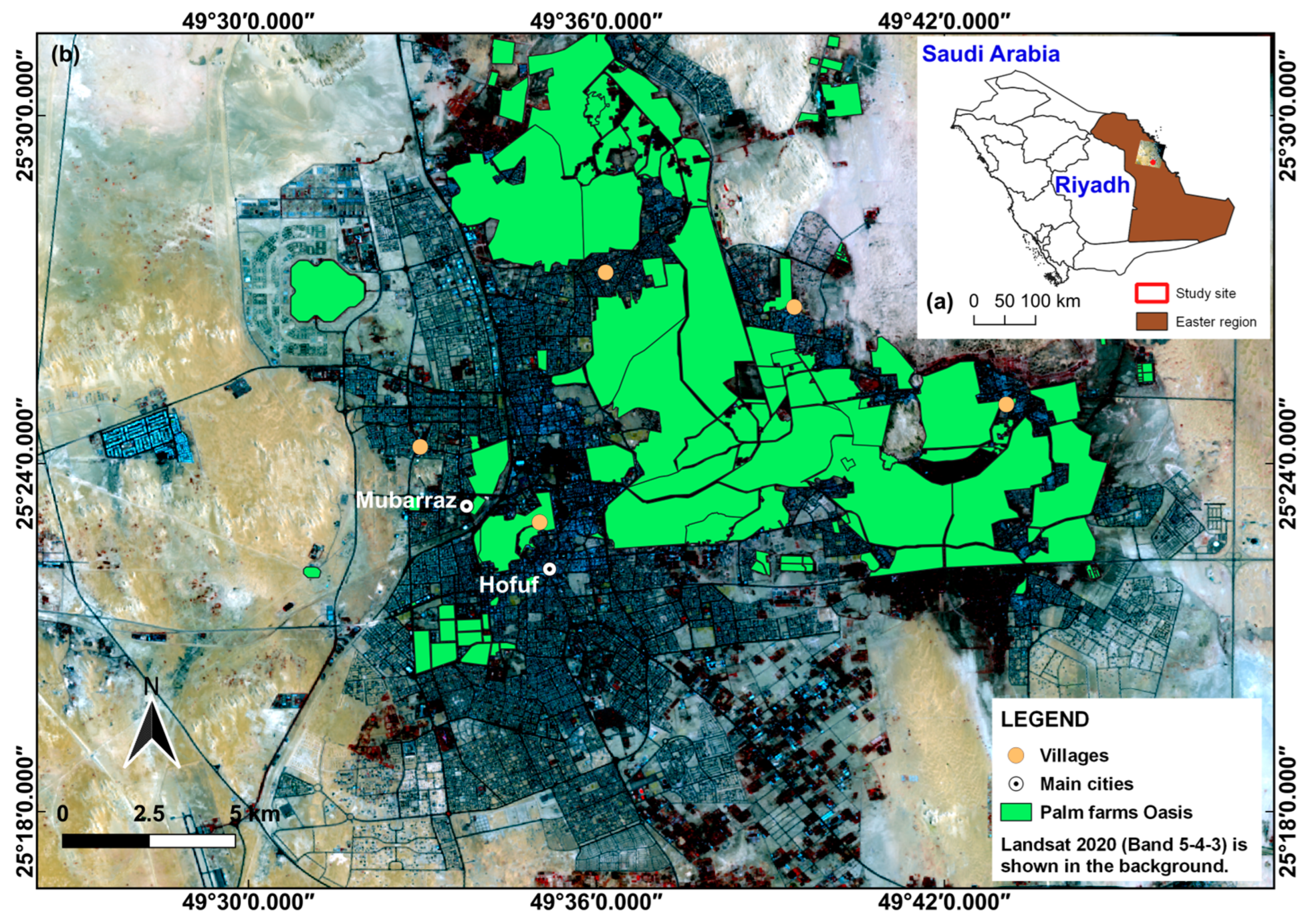
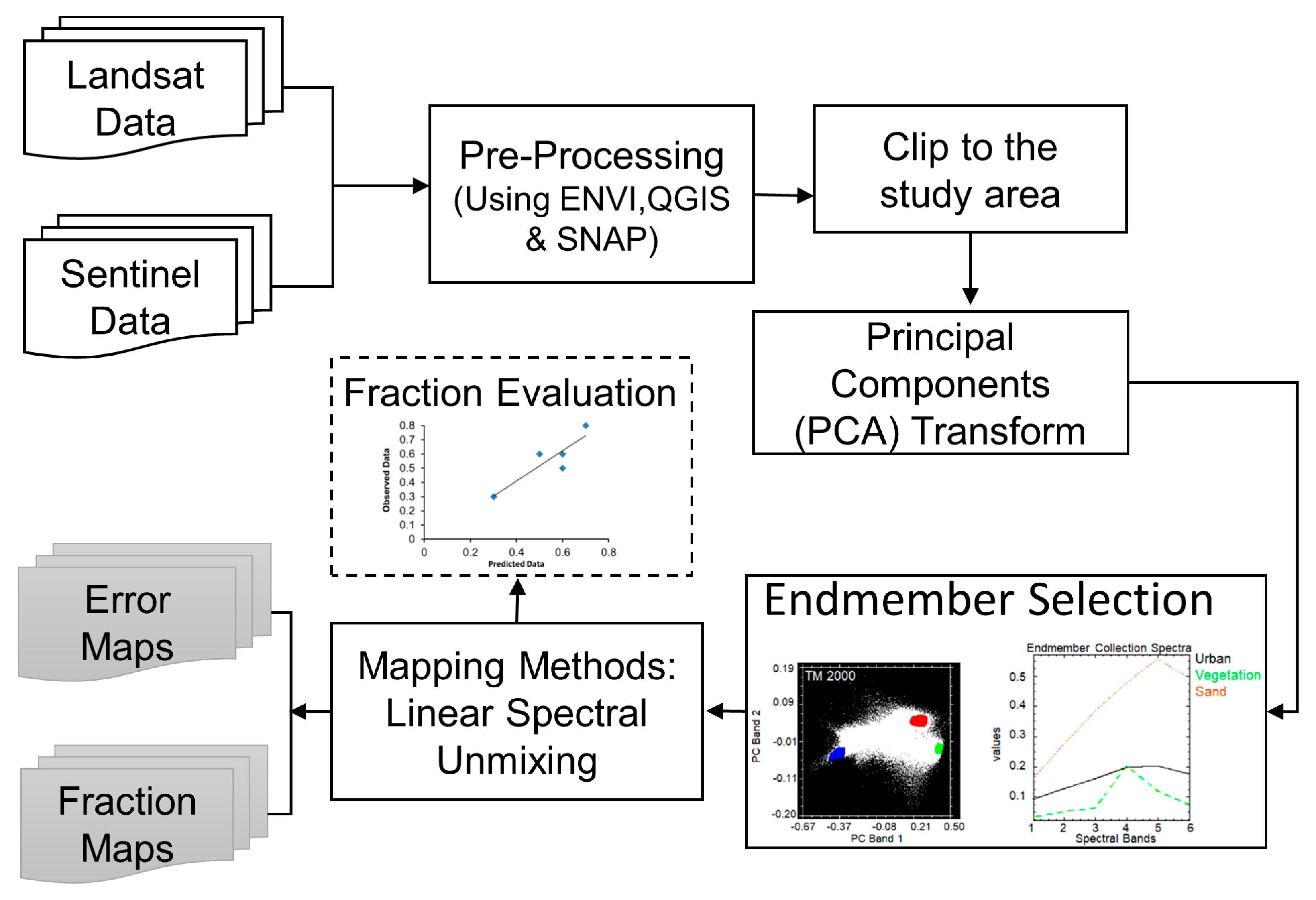
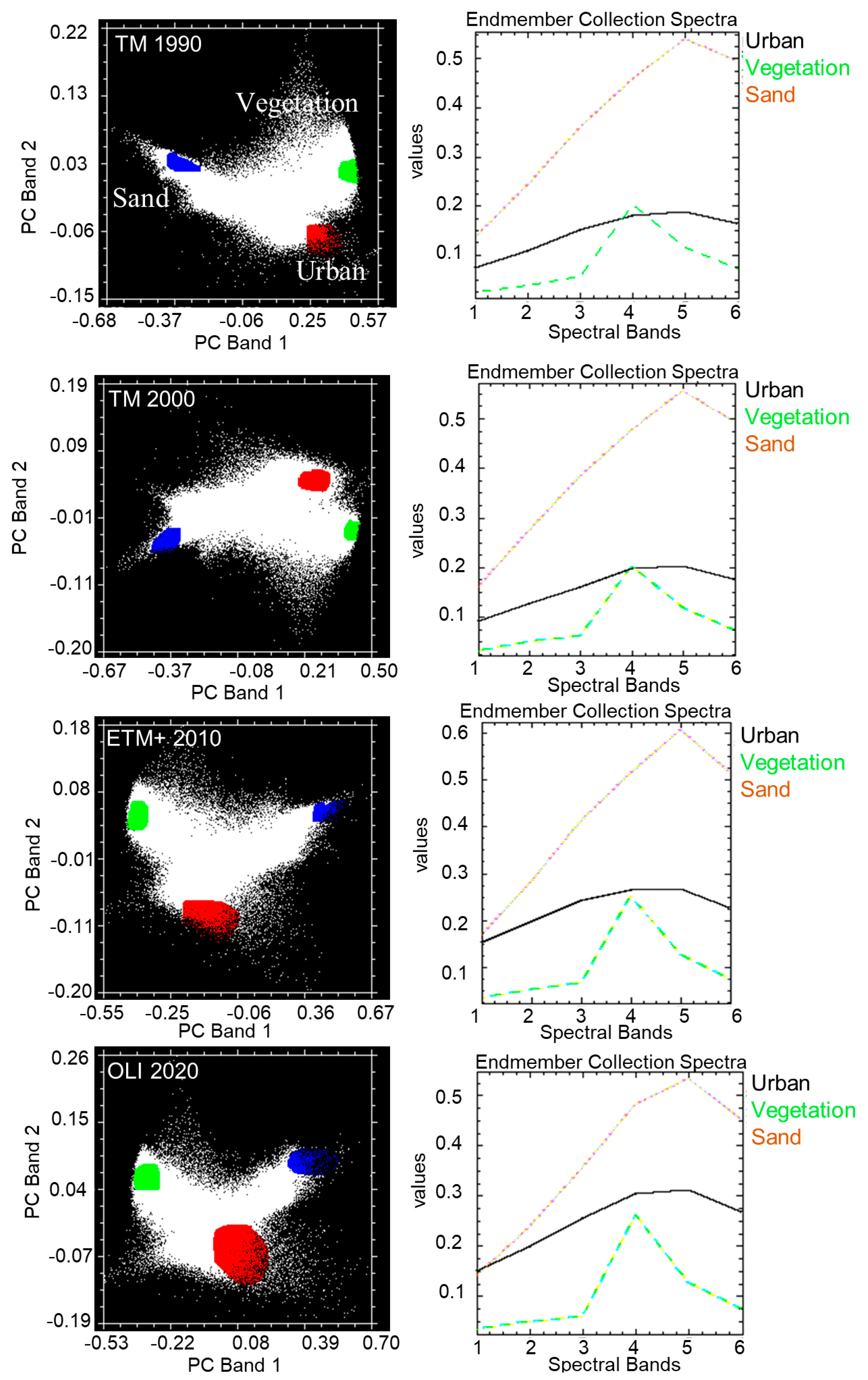
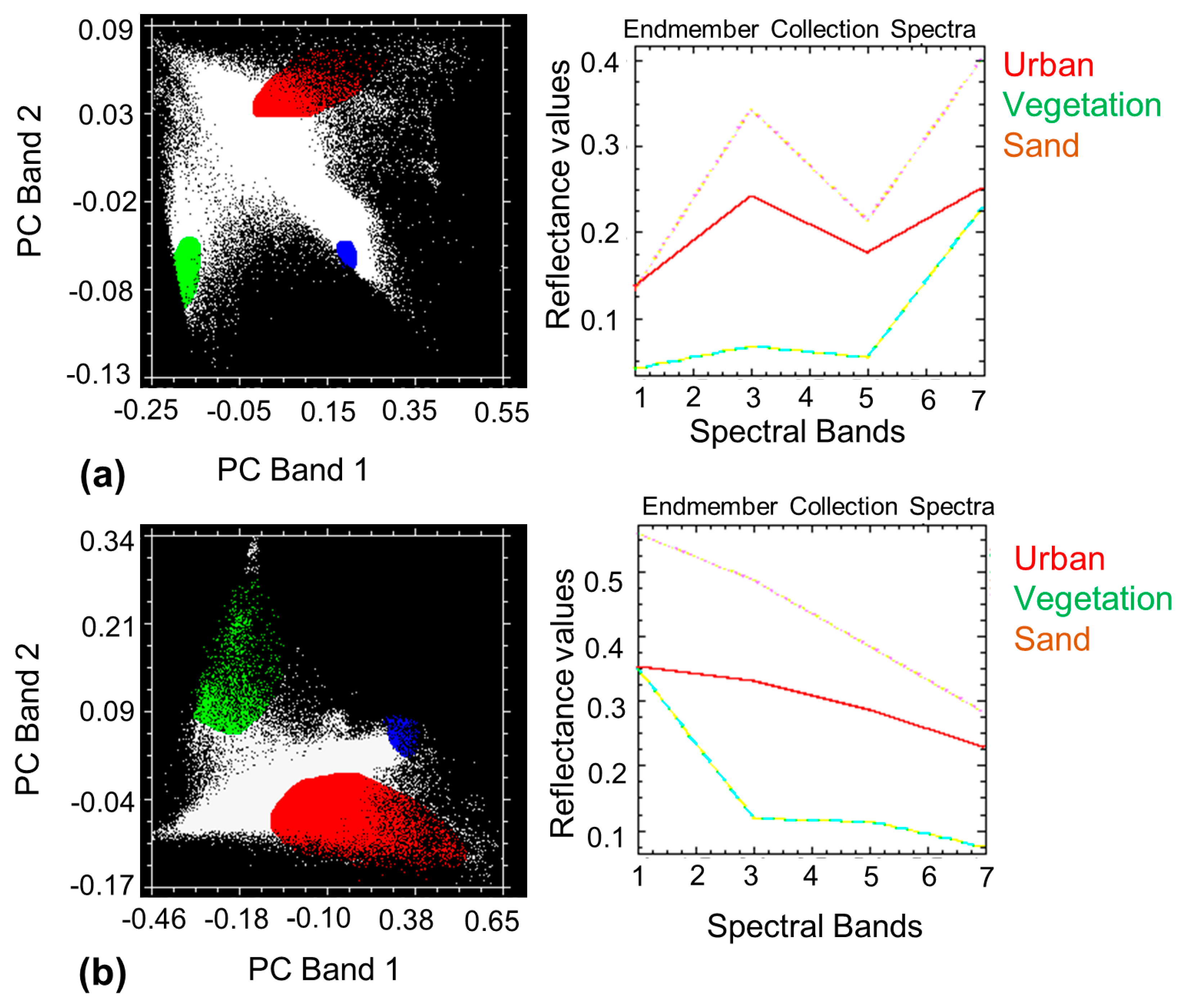
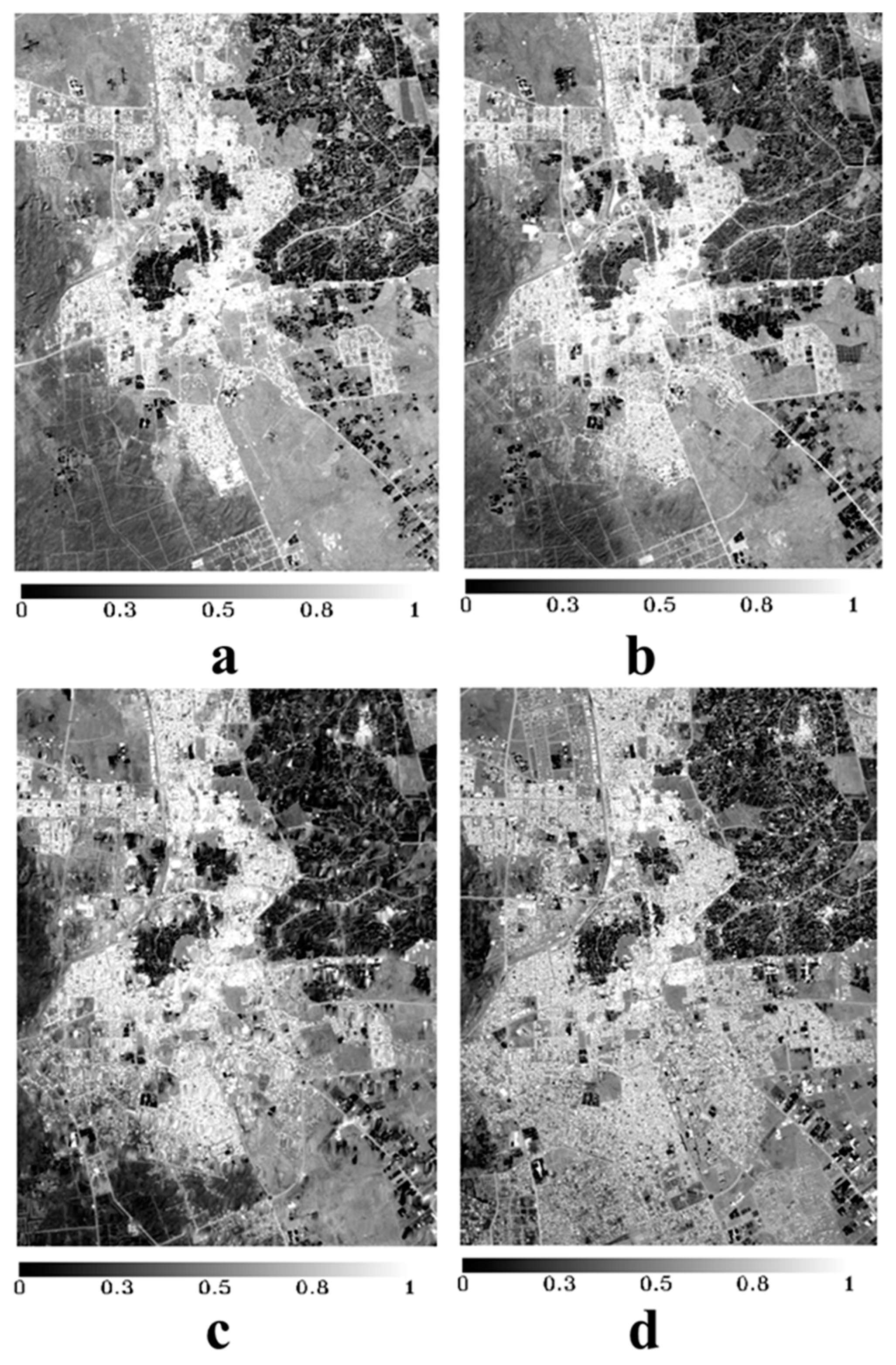
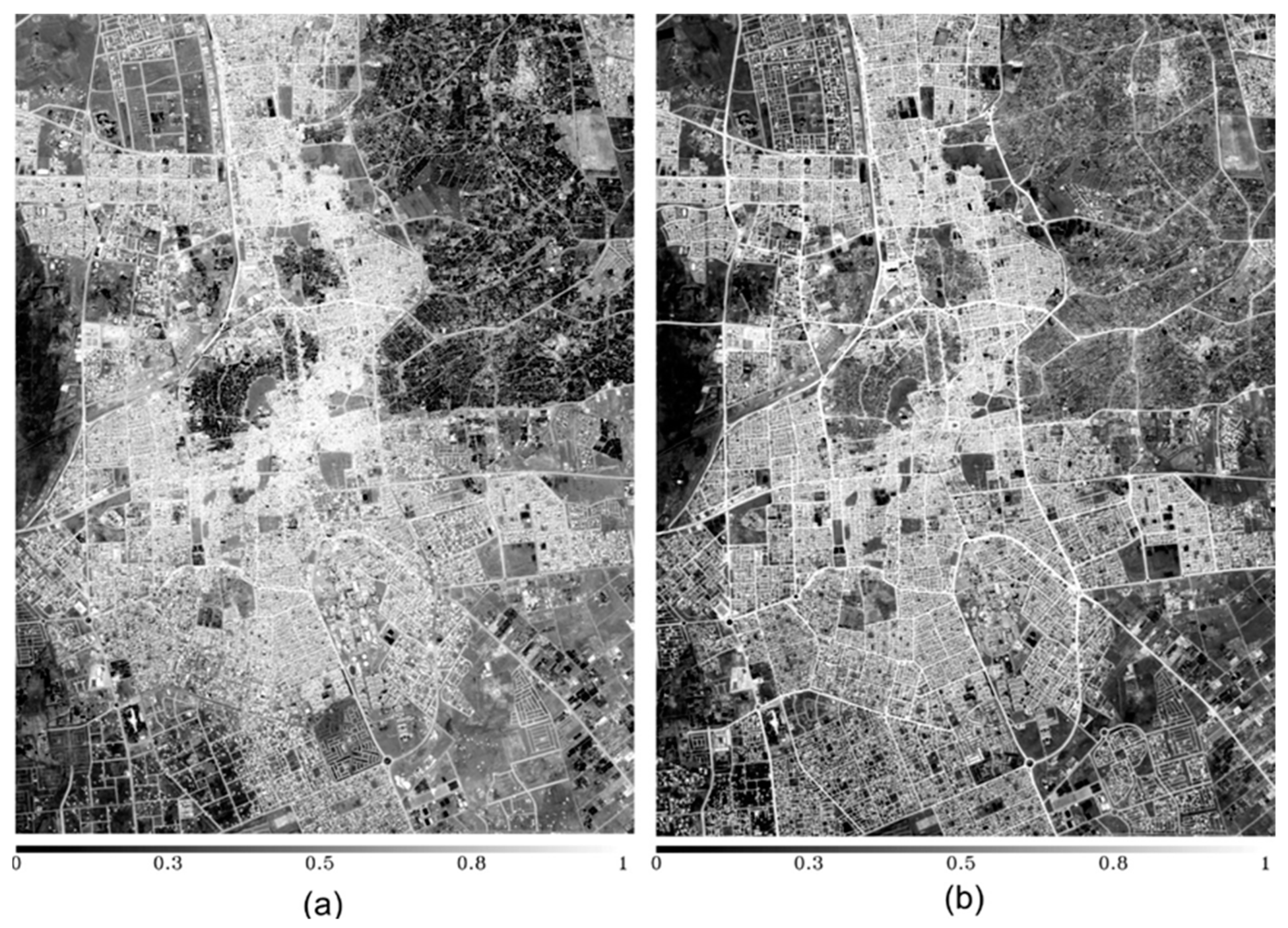



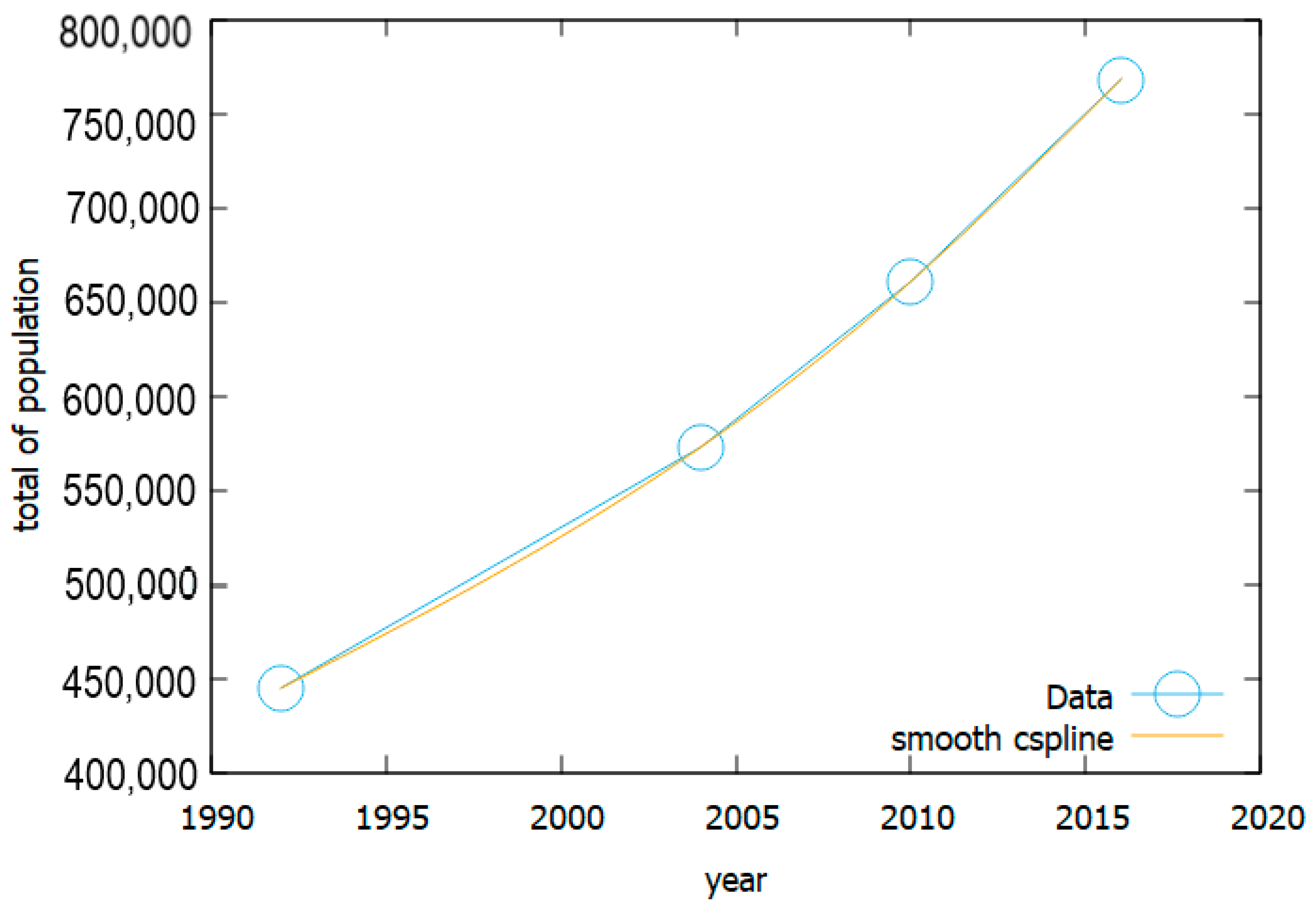
| Sensor-ID | Spacecraft-ID | Acquired Date | No. of Bands | Resolution (m) |
|---|---|---|---|---|
| TM | Landsat-5 | 15 July 1990 | 6 (optical), 1 (thermal) | 30 m (optical), 120 m (thermal) |
| ETM+ | Landsat-7 | 2 July 2000 14 July 2010 | 6 (optical), 2 (thermal) | 30 m (optical), 120 m (thermal) |
| OLI and TIRS | Landsat-8 | 17 July 2020 | 8 (optical), 2 (thermal) | 30 m (optical), 100 m (thermal) |
| MSI | Sentinel-2 | 10 July 2015 19 July 2020 | 1 (coastal aerosol), 3 (red edge), and 7 (optical) | 10–60 m |
| Years | RMS Residual Value of Landsat | RMS Residual Value of Sentinel-2A |
|---|---|---|
| 1990 | 0.013 | NA |
| 2000 | 0.010 | NA |
| 2010 | 0.011 | NA |
| 2015 | NA | 0.006 |
| 2020 | 0.012 | 0.008 |
| Fraction | 1990 | 2000 | 2010 | 2020 | ||||||||||||
|---|---|---|---|---|---|---|---|---|---|---|---|---|---|---|---|---|
| UA% | PA% | OE | CE | UA% | PA% | OE | CE | UA% | PA% | OE | CE | UA% | PA% | OE | CE | |
| Urban fraction | 86 | 100 | 0 | 14 | 90 | 100 | 0 | 10 | 96 | 100 | 100 | 4 | 100 | 100 | 0 | 0 |
| Non-urban fraction | 100 | 88 | 12.3 | 0 | 100 | 91 | 9.1 | 0 | 100 | 96 | 96 | 0 | 100 | 100 | 0 | 0 |
| Overall accuracy (OA) | 93 | 98 | 100 | 100 | ||||||||||||
| Fraction | 2015 | 2020 | ||||||
|---|---|---|---|---|---|---|---|---|
| UA% | PA% | OE | CE | UA% | PA% | OE | CE | |
| Urban fraction | 100 | 100 | 0 | 0 | 100 | 100 | 0 | 0 |
| Non-urban fraction | 100 | 100 | 0 | 0 | 100 | 100 | 0 | 0 |
| Overall accuracy (OA) | 100 | 100 | ||||||
Disclaimer/Publisher’s Note: The statements, opinions and data contained in all publications are solely those of the individual author(s) and contributor(s) and not of MDPI and/or the editor(s). MDPI and/or the editor(s) disclaim responsibility for any injury to people or property resulting from any ideas, methods, instructions or products referred to in the content. |
© 2023 by the author. Licensee MDPI, Basel, Switzerland. This article is an open access article distributed under the terms and conditions of the Creative Commons Attribution (CC BY) license (https://creativecommons.org/licenses/by/4.0/).
Share and Cite
Salih, A. Spectral Mixture Analysis (SMA) Model for Extracting Urban Fractions from Landsat and Sentinel-2A Images in the Al-Ahsa Oasis, Eastern Region of Saudi Arabia. Land 2023, 12, 1842. https://doi.org/10.3390/land12101842
Salih A. Spectral Mixture Analysis (SMA) Model for Extracting Urban Fractions from Landsat and Sentinel-2A Images in the Al-Ahsa Oasis, Eastern Region of Saudi Arabia. Land. 2023; 12(10):1842. https://doi.org/10.3390/land12101842
Chicago/Turabian StyleSalih, Abdelrahim. 2023. "Spectral Mixture Analysis (SMA) Model for Extracting Urban Fractions from Landsat and Sentinel-2A Images in the Al-Ahsa Oasis, Eastern Region of Saudi Arabia" Land 12, no. 10: 1842. https://doi.org/10.3390/land12101842
APA StyleSalih, A. (2023). Spectral Mixture Analysis (SMA) Model for Extracting Urban Fractions from Landsat and Sentinel-2A Images in the Al-Ahsa Oasis, Eastern Region of Saudi Arabia. Land, 12(10), 1842. https://doi.org/10.3390/land12101842







